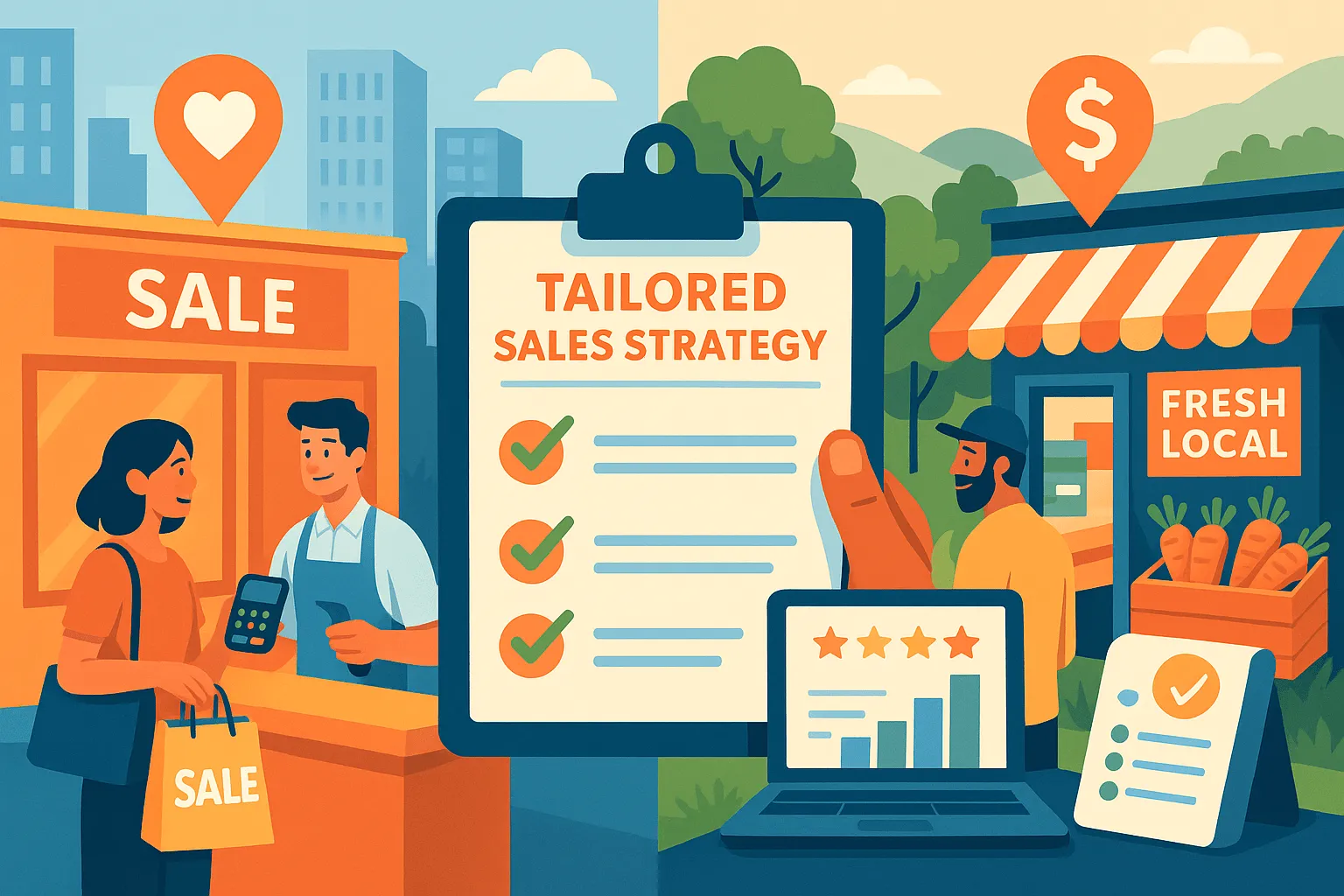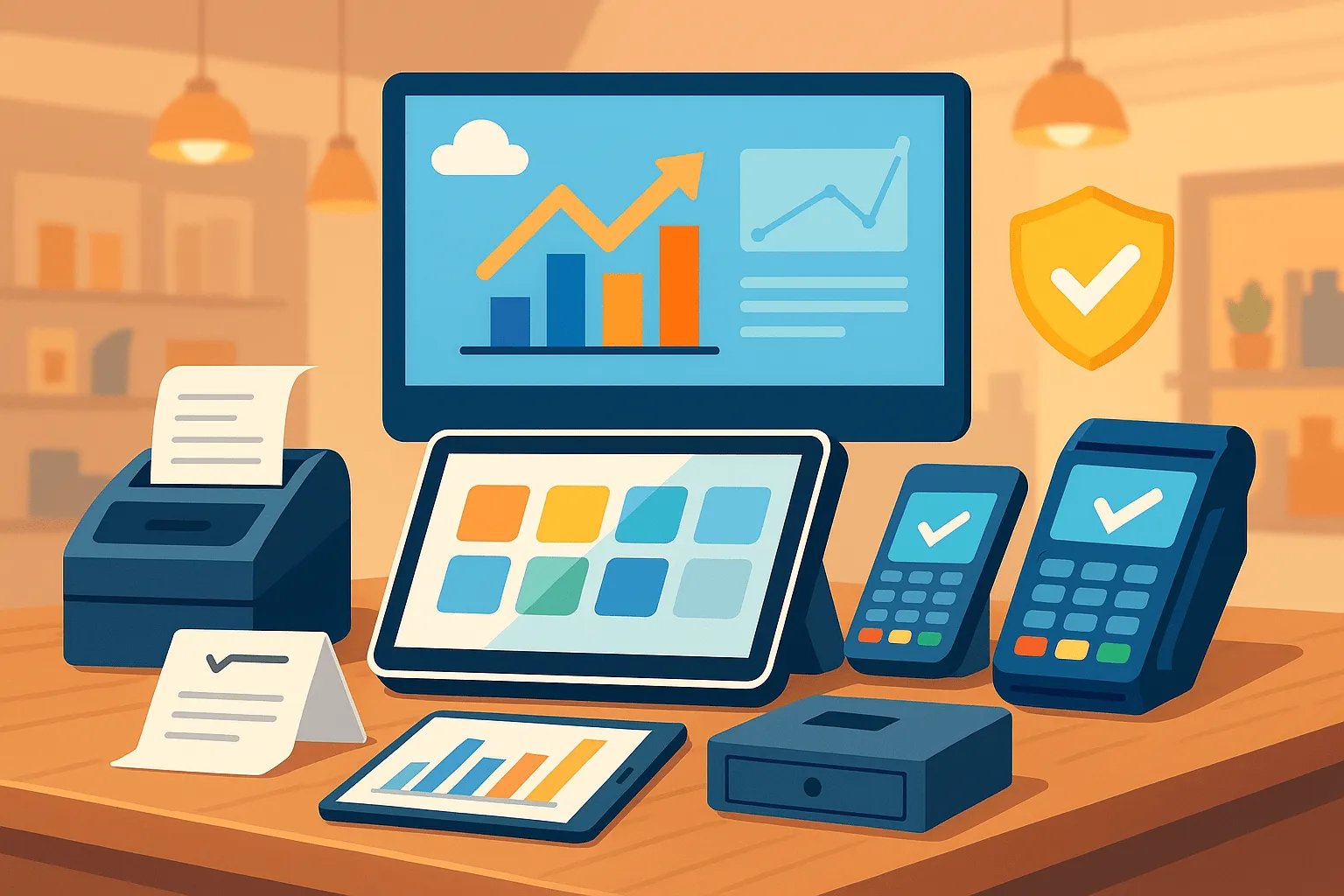What Is a Sales Point?

A sales point is a key reason why someone buys your product. It can be a benefit like “free delivery,” a feature like “touchscreen display,” or even a promise like “30-day returns.” It helps your customer say, “This is worth it.” Good sales points focus on the customer's needs, not just product specs.
In retail or food businesses, sales points should be clear, helpful, and visible right when the customer is about to decide.
“Shoppers decide in under 8 seconds whether to explore a product further. A sales point that hits fast and right wins.” — Nielsen Retail Study, 2024
Difference Between Sales Point and Point of Sale (POS)
Why a Mobile POS System Makes Sales Points More Flexible
Using a mobile POS system gives you more control over how and where you show your sales points. It’s fast, flexible, and works in store or on the go.
Here’s why small and retail businesses love it:
- You can take orders and highlight offers on mobile devices right where the customer is.
- It connects with your POS software, payment processing, and even your back office. Retail POS systems simplify everything—from payment processing to customer tracking.
- Sales points like “accepts major credit cards” or “rewards for repeat customers” can be shown at checkout using built-in payments.
- With a cloud based point system, updates are automatically updated across multiple stores.
According to Square’s 2024 SMB Survey, 62% of small business owners said a mobile POS system helped increase customer satisfaction and purchase speed.
Key Elements of an Effective Sales Point

1. Clear Value Proposition
A clear value proposition tells people exactly what they’ll get and why it matters. It’s not a slogan. It’s a promise.
How to do it right: Make sure your message is short, honest, and easy to understand—even for someone new to your product. A strong sales point often becomes the reason a new client chooses your store over competitors.
Here’s how you can sharpen your sales point with clarity:
- Use your POS system to display benefits like “Save 10% on your first order” or “Works with all mobile devices.”
- Show pricing clearly and add value upfront. For example: “Free local delivery with orders over $50.”
- Use detailed reports from your back office to find what your top customers love—and highlight it.
- Make sure this value is consistent across all your locations by syncing your cloud based point platform.
“If your customer has to guess why they should care, they won’t.” — Seth Godin
2. Focused on Customer Benefits, Not Features
Don’t just say what your product has—say what your product does for them. That’s what people care about.
How to make your sales point more benefit-focused:
- Instead of saying, “This scanner is fast,” say, “Scan more items in less time and reduce checkout lines.”
- Your POS software might include payment processing and built in payments, but the benefit? “Faster checkout, happier customers.”
- Use real time reports to discover which sale software perks are actually being used, then highlight those as customer wins.
- Don’t list every feature—focus on what solves a problem for the customer.
Example: A retail business using barcode scanners and receipt printers might say: “We help you check out in seconds and track every sale—without lifting a finger.”
3. Solves a Real Problem
A strong sales point should solve a real issue your customer faces. If it doesn’t help them, they won’t care.
How to apply it: Think about what your buyer struggles with. Are long checkout lines a problem? Do they worry about data security or product returns?
Use these simple tactics to fix that:
- Highlight your solution, not just the feature. Instead of: “Includes barcode scanner,” say: “Quick scans mean no waiting at checkout.”
- Use your POS system to track slow-selling items and update offers in real-time.
- Use analytics and detailed reports from your back office to understand what customers complain about and solve it.
- If you run multiple stores, align your sales points with the common pain points in each location using a cloud based point setup.
“Solving a problem earns attention. Solving it fast earns loyalty.” — Retail Dive, 2023
4. Backed by Evidence or Proof

Don’t just say your product is great. Prove it. Back your sales point with real stats, testimonials, or features people trust.
How to do this effectively:
- Use real numbers: “Used by 5,000+ happy customers across 3 countries,” or “Handles payment processing for over 50,000 transactions a week.”
- Show it in action. Use POS software to display reviews or product success stories in store.
- Offer receipts that include customer feedback links via your receipt printer.
- Highlight certifications, awards, or guarantees. If your system accepts major credit cards and debit cards, show logos. They build trust instantly.
- Make use of tech: Use your mobile POS system to show product demo videos or compare prices using real time reports.
Customers trust facts. If they see other people getting results, they’re more likely to believe your offer.
5. Emotionally Engaging
A good sales point should make people feel something—safe, happy, excited, or even relieved.
People don’t just buy with logic. Emotions guide most buying choices. According to Harvard Business Review, 95% of purchase decisions happen in the subconscious mind.
How to make your sales point emotionally engaging:
- Use stories. Instead of saying “fast checkout,” tell a quick story: “Our customer Sarah, a busy mom, finished checkout with our mobile POS system in just 30 seconds—no lines, no stress.”
- Tap into feelings like trust, joy, or relief: “Accepted at all your locations, so you never miss a discount,” or “Enjoy quick returns with no questions asked.”
- Highlight perks like built in payments, customer loyalty rewards, or local delivery—small things that make people feel valued.
- Add trust signals like: “Used by over 10,000 happy customers,” or “Safe payments with all major credit cards and debit cards.”
6. Tailored to Your Ideal Customer
One-size-fits-all doesn't work. Your sales point should speak directly to the person you're trying to reach.
How to do it right:
- Use data from your inventory management system and detailed reports to understand what your best business types are buying. Then, tailor your message.
- Example: If you're a retail business, say “Scan and sell quickly with our all-in-one POS setup.” For a business food operation, say “Take orders fast with mobile devices from table to kitchen.”
- Update messages based on season, region, or store using a cloud based point system. This keeps your sales points automatically updated across multiple stores.
- Use insights from your back office to craft offers by location, shopping habits, or even payment methods.
7. Visible Where It Matters
A great sales point won’t help if customers don’t see it. You need to show it at the right time and place—online, at checkout, or in store.
How to make it visible:
- Add your key benefit on product tags or screens in your pos system.
- Display the offer at the counter using your receipt printer or POS hardware.
- Train staff to say it out loud during the sale.
- Use your mobile pos system to highlight the benefit while helping customers on the floor.
- Show proof or limited-time urgency like: “Only 3 left—our top selling item this week!”
8. Supports the Bigger Sales Message
A sales point isn’t a one-off line. It should fit your full message—from product to checkout to receipt.
How to stay consistent:
- Align it with your brand promise. Example: If you sell ease, say it across your software, packaging, and website.
- Use pos software and real time reports to test which messages work and stay on-brand.
- Support it with facts: “Rated #1 in customer loyalty across 3 retail business categories.”
- Build your message into every system: barcode scanner, back office, and even follow-up emails.
How Sales Points Influence Customer Loyalty

A great sales point does more than sell a product. A strong sales point—like “locally sourced,” “lifetime warranty,” or “eco-friendly”—sets your brand apart from the first interaction. That uniqueness builds long-term memory and trust.
Sales points tied to values (sustainability, social impact, safety) tap into personal beliefs. When your mission aligns with theirs, you earn loyalty beyond price.
Sales points like “members get free local delivery” or “exclusive early access to top-selling items” drive engagement in customer loyalty initiatives.
In-Store vs Online Sales Points: What Works Better?
Both have strengths. Let’s break it down:
In-Store Sales Points
- Face-to-face service builds personal relationships.
- You can offer help, suggest more items, or handle complaints fast.
- Works great for retail business with walk-ins.
- Useful tools: barcode scanners, receipt printers, and cash drawers make it easy for staff.
Example: A clothing store uses a mobile pos system to let customers pay from the fitting room. That saves time — and wins loyalty.
Online Sales Points
- Fast for people who prefer shopping from home.
- Let them use debit cards, major credit cards, or even pay through digital wallets.
- Many platforms now support built-in payments and real-time reports for easy tracking.
Tip: Give customers options. Use both in-store and online sales points to serve all business types and grow repeat sales.
Sales Points that Speed Up and Simplify Payment Processing
Slow checkouts turn people away. You need sales points that are fast, smart, and simple.
Here’s how to improve:
- Use a cloud based point system that updates automatically.
- Accept all types of payment, including mobile devices and major credit cards.
- Offer local delivery for online orders to boost trust.
- Connect all your locations so multiple stores share the same system.
How to Use Sales Points to Improve Retail Operations

1. Connect Sales Points to Real-Time Inventory Management
Your sales point should talk directly to your inventory management system. This means when you sell something, your stock level updates automatically.
How it helps:
- No manual updates. No stock errors.
- Prevents overselling or stockouts.
- Speeds up reordering decisions.
Example: Say you run a retail business with multiple stores. A sale at Store A reflects instantly in the system, so Store B doesn’t accidentally promise the same item.
“Switching to cloud POS with inventory sync saved us 12 hours a week and avoided 3 major order errors.”
2. Make Sales Points Visible at Checkout
Don’t hide offers. Sales points should show clear benefits—like “Buy 2, Get 1 Free” or “Earn rewards on this purchase.”
How it helps:
- Drives impulse purchases.
- Improves customer loyalty.
- Speeds up decisions at checkout.
Implementation Ideas:
- Add digital displays next to pos hardware.
- Use receipt printer messages to highlight future deals.
- Allow discounts based on payment processing choices (e.g., major credit cards or debit cards).
3. Tailor Sales Points Based on Store Location

One-size-fits-all doesn’t work. Customize sales points depending on the store location and local customer needs.
How:
- Urban stores? Push fast checkout with mobile pos system.
- Rural stores? Highlight cash discounts or offline options with cash drawer setups.
- Near schools? Promote snack or business food combos.
Smart Use:
- Run A/B testing for different sales point messages by location.
- Review detailed reports weekly to track which offers perform best.
4. Empower Staff with Ready-Made Talking Points
Your team should always know what to say to customers. Clear, easy talking points help employees feel confident.
What to do:
- Create short scripts based on top selling items.
- Add product benefits and answers to common questions.
- Use these across multiple stores for a consistent message.
When your team explains the product well, people buy more. A study by Retail Dive shows trained staff increases upsells by 23%.
5. Simplify Promotions Across All Your Locations
Running discounts? Make sure every location handles it the same way.
How to make it simple:
- Use your POS software to schedule and apply deals.
- Link your back office to update prices in store instantly.
- Print offers automatically on receipts using your receipt printer.
Confusion over promotions frustrates customers and slows down checkout. Automating it across all your locations keeps your retail business running smoothly.
6. Boost Cross-Sells and Upsells at the POS
Don’t miss out on extra revenue at the point of sale. Train your team to suggest smart add-ons.
Here’s how:
- Use your cloud based point system to flag matching items.
- Show staff alerts on their pos devices.
- Offer bundles or limited-time upgrades at checkout.
Real-world tip: If someone buys a sandwich, offer a drink combo. These small transactions add up fast.
“Upselling added 17% more to our average sale per customer,” says The Local Deli, a small business food outlet in Chicago.
Best POS Software for Small and Medium Businesses

Many POS systems can run on a basic tablet or desktop computer—no need for a complex setup. Below are the top POS softwares to consider:
- Square POS: Square is one of the easiest point of sale tools to set up. It runs well on mobile devices, has a free plan, and comes with payment processing. You get a receipt printer, cash drawer, and card reader included in some hardware kits. It works great for pop-up stores and food trucks.
- You can also purchase hardware bundles that include a receipt printer, barcode scanner, and touchscreen tablet.
- Lightspeed Retail: This cloud based point solution is ideal for retail operations with complex inventory management. It includes a barcode scanner, detailed reports, and helps you spot top selling items. It also connects with eCommerce and supports multiple stores.
- Shopify POS: Perfect for those already using Shopify for online sales. This POS software offers real-time sync between online and in store orders. It supports debit cards, major credit cards, and integrates with back office tools for revenue tracking.
- Toast POS: If you run a business food operation like a restaurant or cafe, Toast POS is for you. It comes with sale software, built in payments, and menu items editing. It also works offline, so your orders stay up even without internet connection.
- Vend (by Lightspeed): Vend is great for growing retail stores. It offers automatically updated analytics, customer loyalty programs, and supports multiple business types. You can use it on your own device or buy POS hardware from Vend.
- Zettle by PayPal: Zettle is best for mobile-first setups. It’s affordable and offers a smooth checkout with POS devices. It helps small businesses accept payments quickly and comes with simple tools to manage your sales data.
How to Enhance Your Sales Point with Data and Insights

To enhance your sales point with data, start by tracking real-time performance through your POS system. Use detailed reports to understand what messaging drives conversions—like “free local delivery” or “limited stock.”
Some modern POS systems now use artificial intelligence to suggest personalized offers based on real-time buying behavior.
Analyze customer behavior, spot top-selling items, and tailor promotions per business type or store. Tools like back office dashboards help predict trends, while POS software automates smart, personalized upsells that improve revenue without extra work.
How the Back Office Powers Smarter Sales Point Decisions

Your back office is where you track, measure, and manage everything behind the scenes. It connects with your point of sale system to give real insights. For example, it tells you which menu items sell the most, what times are busiest, and how your team performs.
With smart tools, you can:
- Sync inventory management with live sales so nothing runs out.
- See which barcode scanner items move fast vs. slow.
- Get real time reports that show your best and worst days.
- Spot delays in payment processing or cash drawer issues.
- Plan staffing better with detailed reports from each store
How Detailed Reports Reveal Which Sales Points Actually Work
Some sales points bring in more money than others. But how do you know which ones? Detailed reports help you compare across multiple stores or in store counters.
These reports tell you:
- Which receipt printer locations serve the most customers
- Which days have the most transactions. With a smart POS setup, you can track performance by the hour, store, or business day to fine-tune your operations.
- Which business types spend more
- Where payment is faster (like debit cards vs. major credit cards)
- What drives customer loyalty (like speed, staff, or offers)
Make sure your POS software includes all the features you need—inventory, payments, loyalty programs, and mobile access.
How to Scale Your Sales Point Across Multiple Stores and Different Business Types

1. Use a Cloud-Based POS System for Central Control
Running many stores? Don’t juggle different systems. A cloud-based point of sale system lets you manage all your store locations from one place. Your inventory, sales data, and customer info stay in sync—even across multiple stores.
“With cloud POS, I can update prices or menu items once, and they change across all our locations instantly,” says James, a retail chain manager in Texas.
Why this works:
- You avoid errors from outdated systems.
- You get real time reports from every point of sale.
- You save time and cut back office headaches.
2. Customize Sales Points by Store Location
Not every customer thinks the same. A sales point that works in your downtown location might flop in a smaller town. Use your POS system to track which sales points convert in each location.
Let’s say your city store responds to “cashback on debit cards,” while your suburban shop loves “free local delivery.” You can run both without confusion—thanks to detailed reports and analytics.
Tips to do this right:
- Segment your data by store and business types.
- Test what messaging works in different places.
- Update in store marketing based on results.
3. Using Cloud-Based Point Systems to Scale Consistently

Scaling means growing without losing control. A cloud based point system helps you expand without repeating setup for every location. You can:
- Roll out new sales points to all your locations with one click.
- Keep pricing and inventory management consistent.
- Offer customer loyalty rewards across every store.
“It’s like having a single brain for the entire retail business,” says Priya, owner of a growing clothing chain.
Plus, you get built-in tools like automatically updated menus and receipt printer support, so each POS system runs the same—no matter where.
4. Support Multiple Business Types from One Platform
If you’re running a retail business, a business food outlet, or any other model, your POS system must support different business types. No matter your industry—retail, food, or services—your POS must support your business flow.
A flexible platform lets you manage inventory, track transactions, and offer custom pricing based on the store.
"Unified systems help businesses reduce operating costs by up to 20%." – Statista, 2024
Tips:
- Choose POS software that works across retail operations and food services.
- Look for systems that support menu items, barcode scanner features, and cloud based point solutions.
- Make sure it handles sales tax rules for each location.
5. Equip Each Store with the Right POS Hardware
Every store has unique needs. While some stores use mobile devices, others rely on full setups with receipt printers, cash drawers, and POS hardware.
Example: A boutique store may need sleek pos devices, while a café might need a receipt printer near the counter.
Essentials per store:
- Pick hardware that fits store layout and customer flow.
- Use automatically updated device firmware for reliability.
- Connect your system over a stable internet connection.
6. Use Built-In Payments and Loyalty Offers to Reinforce Value
Built in payments reduce delays at checkout. Pair this with customer loyalty offers to boost repeat purchases. Modern payment processing tools also support major credit cards and debit cards, keeping transactions smooth.
How to implement:
- Add digital punch cards or points systems.
- Use a mobile POS system that supports local delivery and all your locations.
- Personalize loyalty offers using detailed reports and customer purchase data.
7. Monitor and Optimize with Real-Time Analytics
Don’t guess what works—track performance using real time reports and analytics. Use this data to refine your sales point messaging across multiple stores.
What to track:
- Your top selling items
- Conversion rates at different point of sale setups
- Store-wise revenue, software uptime, and customer flow
Conclusion
To grow your sales point, use tools that are fully integrated with your POS system. “Today’s retailers need innovation and control,” says Retail Tech Insights. Whether you run multiple locations or serve other businesses, smart hardware and real-time services help you manage faster. Don’t forget to test and improve—every sales point should evolve with your customers.





.png)
.jpg)

